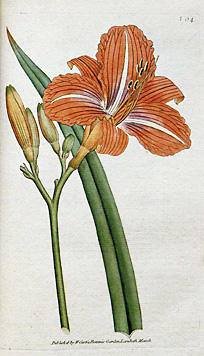Daylong Daylily
By Audrey Stallsmith

Consider
The lilies of the field whose bloom is brief:--
We are as they;
Like them we fade away,
As doth a leaf.
“Consider” by Christina Rossetti
My daylilies are blooming extraordinarily well this year, despite the weatherman informing us that the last 12 months have been the wettest on record here. But, since the wild orange daylilies grow so profusely in ditches, we can conclude that they must like water.
Calling the tawny ditch lilies, AKA Hemerocallis fulva, “wild” actually is a misnomer, since they weren’t originally native to the U.S. Even calling them “lilies” technically is inaccurate, since they belong to the Hemerocallis rather than the Lilium genus.
Being so easy to grow, however, they were passed from one gardener to another so often that they eventually became naturalized. Especially showy, but more often found in gardens than ditches, is the double version: Hemerocallis fulva ‘Kwanso.’
The yellow-flowered lemon lily (Hemerocallis lilasphodelus) sometimes also goes wild hereabouts, but blooms earlier—generally in late May or early June—and is much more fragrant than the July-blooming fulva. Both of these Hemerocallis species seem to have originated in the Orient, but aren’t called Oriental lilies, since that designation is reserved for one of the true lilies.
Hemerocallis derives from the Greek hemera (“day”) and kalos (“beautiful”). As that name implies, each bloom lasts only one day before "fading away." But, since there generally are several buds per stalk, the withered ones are quickly replaced. Unlike true lilies, which grow from scaly bulbs, daylilies grow from fleshy roots which may sometimes produce potato-like tubers.
Although daylilies have been used in the Orient to treat breast ailments and a variety of other ills, and their blooms often are eaten by adventurous gardeners, their edibility still remains in dispute. They don’t seem to have bothered our ducks who a couple years back pulled—and, I’m guessing, consumed!—the majority of new daylily seedlings that I had planted.
However, while A Field Guide to Medicinal Plants and Herbs of Eastern and Central North America calls the flowers edible, it reports that the roots and young shoots may contain toxic colchichine. And ingestion of the plants reportedly can sometimes cause renal (kidney) failure in both cats and cattle.
So I would stick to growing them for their beauty. Thanks to Dr. Arlow Stout, who produced some of the first daylily cultivars, there are thousands of them today. Including three of my own that the ducks overlooked!
Daylilies are easy to cross, since they often will bloom in their second year from seed, just as other perennials do. So it can be fun to plant your own hybrids and see what results from them. Since I’m a bit lazy about doing all that pollinating myself, I usually just sow crosses I’ve received in seed trades from more experienced daylily growers.
My most recent three which the ducks missed waited until their third year to bloom, but that probably was because I didn’t get around to setting them out until very late in their first year. Two of them turned out to be rather plain, but the third was a ruffly double which made all of the aggravation worthwhile!
Hemerocallis fulva image is from Curtis's Botanical Magazine, courtesy of plantillustrations.org.








